A very different kind of top prospect list
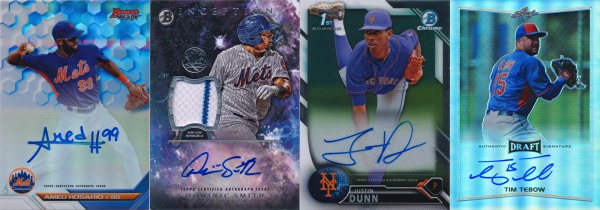 It’s that time of year again when a young (or not-so-young) man’s (or woman’s) fancy (or dread) turns to ordinal rankings of young baseball players. That’s right, top prospect lists! Everyone’s got one and you usually regret looking at the other guy’s. Why should we be any different here? Now, I am not a talent evaluator, so we’re going to have to come up with some other way to rank these guys. And after a comment I made on For All You Kids Out There (For All You Kids Out There is the official podcast of your Baseball Prospectus Mets Local site), the answer became clear – we’ll rank them by the strength of their cardboard.
It’s that time of year again when a young (or not-so-young) man’s (or woman’s) fancy (or dread) turns to ordinal rankings of young baseball players. That’s right, top prospect lists! Everyone’s got one and you usually regret looking at the other guy’s. Why should we be any different here? Now, I am not a talent evaluator, so we’re going to have to come up with some other way to rank these guys. And after a comment I made on For All You Kids Out There (For All You Kids Out There is the official podcast of your Baseball Prospectus Mets Local site), the answer became clear – we’ll rank them by the strength of their cardboard.
This turns out to be a fairly straightforward process, especially with the prospect drought we’ve had in 2016 baseball card products. Across all of 2016, we only got 63 total cards (not counting parallels) featuring Mets prospects; about half of those came in the last month of the year. So once we tally up all of the cards and score them by card type (1 point for base cards, 2 for inserts, 3 for memorabilia, 4 for autographs, 5 for autographed memorabilia, and .5 for anything else), the final score gives us our rankings. Simple objective rankings. With one small twist…
Not all cards are equally valuable, so we’re going to need a weighting factor to account for popular demand. Taking the common autograph price, rounding it to the nearest $10 ($10 minimum), and dividing by 10 should work well enough. For players without autographs, doing the same for base cards with the numbers all divided by 10 should get us in the ballpark. And then we just leave everyone’s scores the same and multiply a certain someone by 5. That gets us a result that no other Mets top prospect list has.
Prospect Eligibility
No top prospect list would be complete without complex and arbitrary rules for eligibility that prevent direct comparisons with other lists. In our case, MLB service time is not a factor, at least not directly. The category of prospect cards came into existence when the MLBPA decreed that, beginning in 2006, no player who has not yet appeared on an active MLB roster shall have a card in a base set, setting the (arbitrarily applied) rules for official Rookie Cards while pushing cards that would once have been considered rookie cards into the ambiguous gray area previously reserved for MiLB and unlicensed cards. So our starting point is simply any pre-RC card from a player, regardless of their prospect eligibility or whether they are a legitimate prospect.
A wrinkle comes in when you have a player with both prospect cards and Rookie Cards issued in the same year, when a player with Rookie Cards in one year has prospect-like cards in the following year, or when a prospect changes teams. Baseball is weird like that sometimes. So we’ll need a few ground rules to account for these peculiar circumstances. Once a player has Rookie Cards issued in a formally released product (sold in packs or factory sets), they lose prospect card eligibility for that manufacturer for the remainder of the year and can no longer be considered eligible for prospect cards in following years. “Year” in this case is product year, not calendar year.
Rookie Cards released in small quantities directly to consumers, through product pack-ins (such as with a pizza at Walmart), or as stadium giveaways do not affect prospect eligibility (but also do not count as prospect cards). All cards from manufacturers not licensed by the MLBPA (which therefore cannot produce Rookie Cards) are considered prospect cards until the year following the player’s RC year. Locally or regionally produced cards (such as minor league team sets and custom produced cards) do not count as prospect cards for these purposes. Amateur cards, even those released in products with qualifying prospect cards, are not considered prospect cards; all qualifying prospect cards must list the team as New York Mets or New York (when unable to use the official team name due to licensing) or their minor league equivalents. In the event of ambiguous or erroneous team naming, a decision will be made based on a best effort to determine the manufacturer’s intent and/or the extent of their screw-up (see: 2013 Topps Pro Debut Travis d’Arnaud).
And with that, let’s get to the list.
10. 7-Way Tie
Raw Score: 1
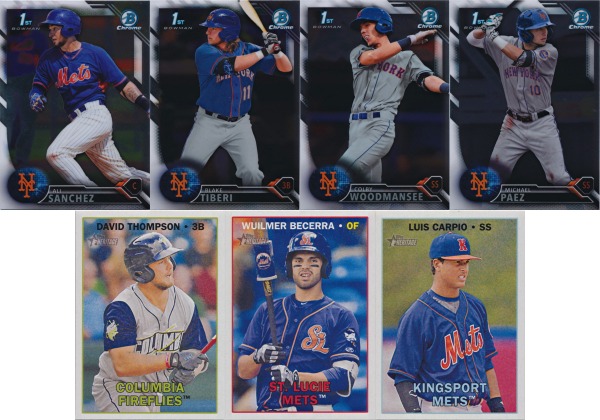 Only nine Mets prospects (plus one exception noted below) had more than one card released in 2016, so there’s a big cluster at the 10th spot. Seven players have a single base card in one of three products: Bowman Chrome (Ali Sanchez), Bowman Draft (Blake Tiberi, Colby Woodmansee, and Michael Paez), and Topps Heritage Minor League (David Thompson, Wuilmer Becerra, and Luis Carpio). These are the first pro cards for all but Becerra and Thompson; Thompson’s card is the first Columbia Fireflies card produced by Topps. With no way to differentiate them, they all get lumped together here.
Only nine Mets prospects (plus one exception noted below) had more than one card released in 2016, so there’s a big cluster at the 10th spot. Seven players have a single base card in one of three products: Bowman Chrome (Ali Sanchez), Bowman Draft (Blake Tiberi, Colby Woodmansee, and Michael Paez), and Topps Heritage Minor League (David Thompson, Wuilmer Becerra, and Luis Carpio). These are the first pro cards for all but Becerra and Thompson; Thompson’s card is the first Columbia Fireflies card produced by Topps. With no way to differentiate them, they all get lumped together here.
9. Gavin Cecchini
Raw Score: 5
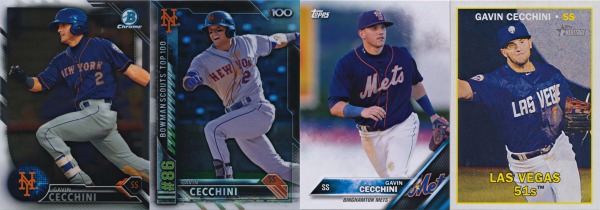 As a first-round pick, Gavin Cecchini was a given to have cards in 2016 and turned up in Bowman and both MiLB products. And while he had no autographs in 2016, he’ll almost certainly have some RC autographs in 2017 (Topps has already revealed an uncut unsigned sheet featuring Cecchini). That’s enough for 9th place on this list.
As a first-round pick, Gavin Cecchini was a given to have cards in 2016 and turned up in Bowman and both MiLB products. And while he had no autographs in 2016, he’ll almost certainly have some RC autographs in 2017 (Topps has already revealed an uncut unsigned sheet featuring Cecchini). That’s enough for 9th place on this list.
8. Desmond Lindsay
Raw Score: 5
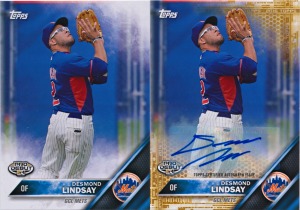 Desmond Lindsay made his pro debut in 2015 and was fittingly featured in 2016 Topps Pro Debut, a product that is often a misnomer for the majority of the checklist (most notably Brandon Nimmo, who has appeared in four straight years). A base card and an autograph (just the second Mets autograph in the 7-year history of the Pro Debut brand) puts Lindsay at the back of the autograph pack and tied with Cecchini in points. Tiebreaker goes to the highest point value card (I just made that up).
Desmond Lindsay made his pro debut in 2015 and was fittingly featured in 2016 Topps Pro Debut, a product that is often a misnomer for the majority of the checklist (most notably Brandon Nimmo, who has appeared in four straight years). A base card and an autograph (just the second Mets autograph in the 7-year history of the Pro Debut brand) puts Lindsay at the back of the autograph pack and tied with Cecchini in points. Tiebreaker goes to the highest point value card (I just made that up).
7. Brandon Nimmo
Raw Score: 8
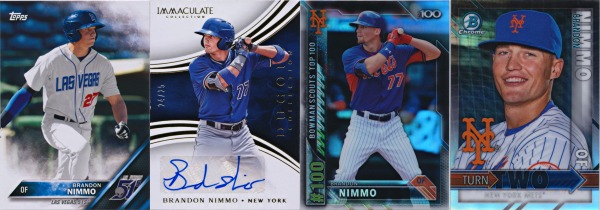 Brandon Nimmo is the only player on this list who had both prospect cards and Rookie Cards released in 2016. That actually puts him at a big disadvantage in both categories. In Rookie Cards, he only has a base card in 2016 Topps Update, an autographed memorabilia card in 2016 Panini Prime Cuts, and various autographed memorabilia cards in 2016 Panini National Treasures (despite some big plays, he didn’t even make the cut for a Topps Now card, the bar for which was absurdly low for other players debuting in 2016). But getting those RCs cost him appearances in late-season prospect products, limiting his prospect cards to just a base card in 2016 Topps Pro Debut, a very limited autograph in 2016 Panini Immaculate Collection (only 36 total cards were produced), and 1.5 inserts in 2016 Bowman. On this list, that’s not enough to even be adjacent to the top five.
Brandon Nimmo is the only player on this list who had both prospect cards and Rookie Cards released in 2016. That actually puts him at a big disadvantage in both categories. In Rookie Cards, he only has a base card in 2016 Topps Update, an autographed memorabilia card in 2016 Panini Prime Cuts, and various autographed memorabilia cards in 2016 Panini National Treasures (despite some big plays, he didn’t even make the cut for a Topps Now card, the bar for which was absurdly low for other players debuting in 2016). But getting those RCs cost him appearances in late-season prospect products, limiting his prospect cards to just a base card in 2016 Topps Pro Debut, a very limited autograph in 2016 Panini Immaculate Collection (only 36 total cards were produced), and 1.5 inserts in 2016 Bowman. On this list, that’s not enough to even be adjacent to the top five.
6. Anthony Kay
Raw Score: 9
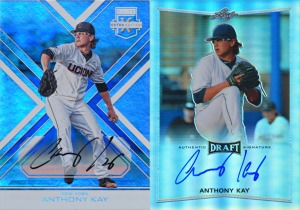 Anthony Kay did not throw a professional pitch in 2016 and wound up needing Tommy John surgery, the risk of which allowed the Mets to cut his bonus and use the remainder to sign Cameron Planck. As such, he really has no business on top prospect lists, but this list isn’t the only one with him in the top 10. Kay’s arm was well enough for him to sign for Panini and Leaf in 2016, putting him just outside the top 5. His first appearance in a Mets uniform, cardboard or otherwise, could have to wait until 2018.
Anthony Kay did not throw a professional pitch in 2016 and wound up needing Tommy John surgery, the risk of which allowed the Mets to cut his bonus and use the remainder to sign Cameron Planck. As such, he really has no business on top prospect lists, but this list isn’t the only one with him in the top 10. Kay’s arm was well enough for him to sign for Panini and Leaf in 2016, putting him just outside the top 5. His first appearance in a Mets uniform, cardboard or otherwise, could have to wait until 2018.
5. Pete Alonso
Raw Score: 10
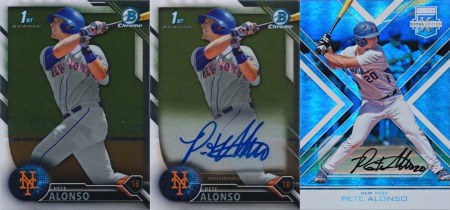 Just a tick above in score, Pete Alonso stepped over the higher-picked Kay to land the second Mets autograph spot in 2016 Bowman Draft. He seems to have changed from Peter to Pete since the draft, though Panini’s checklist still lists him as Peter. That’s all I’ve got. (Crease in the Elite Extra Edition autograph courtesy of the United States Postal Service.)
Just a tick above in score, Pete Alonso stepped over the higher-picked Kay to land the second Mets autograph spot in 2016 Bowman Draft. He seems to have changed from Peter to Pete since the draft, though Panini’s checklist still lists him as Peter. That’s all I’ve got. (Crease in the Elite Extra Edition autograph courtesy of the United States Postal Service.)
4. Amed Rosario
Raw Score: 14
 This may be the only non-global prospect list that puts Amed Rosario this low. At least, it should be, but some of these lists… Rosario has several years worth of cards at this point, including autographs from Panini in 2013 and from Bowman in 2015. Leaf finally got in on the action in 2016 and Rosario’s 5 base cards were the most of any Mets prospect last year. Between base cards and autographs, he has now appeared in 2015 Bowman, 2015 Bowman Chrome, 2015 Bowman Draft, 2016 Bowman, 2016 Bowman Platinum, 2016 Bowman Draft, and 2016 Bowman’s Best. Impressive as that is, it’s not enough to crack the top three, not even close.
This may be the only non-global prospect list that puts Amed Rosario this low. At least, it should be, but some of these lists… Rosario has several years worth of cards at this point, including autographs from Panini in 2013 and from Bowman in 2015. Leaf finally got in on the action in 2016 and Rosario’s 5 base cards were the most of any Mets prospect last year. Between base cards and autographs, he has now appeared in 2015 Bowman, 2015 Bowman Chrome, 2015 Bowman Draft, 2016 Bowman, 2016 Bowman Platinum, 2016 Bowman Draft, and 2016 Bowman’s Best. Impressive as that is, it’s not enough to crack the top three, not even close.
3. Dominic Smith
Raw Score: 33
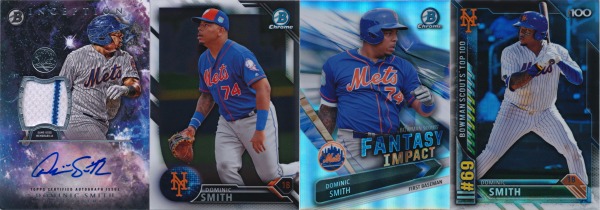 This is also probably the only list that puts Dominic Smith over Amed Rosario. Smith had a breakout season with Binghamton in 2016, refining his hit tool and working plenty of walks while also beginning to develop the power everyone has been waiting for. He still has a few issues that could keep him from becoming the first baseman of the future Mets fans are hoping for, but he’s making progress. In cardboard, he was prominent throughout the year in Bowman and MiLB products with a team-leading 13 total cards and he had the only memorabilia from a Mets prospect in 2016 (from an unspecified source, a pinstripe Mets jersey of some kind). Like Rosario, he appeared in the 2016 All-Star Futures Game and should have memorabilia from that showing up somewhere. Or will he?
This is also probably the only list that puts Dominic Smith over Amed Rosario. Smith had a breakout season with Binghamton in 2016, refining his hit tool and working plenty of walks while also beginning to develop the power everyone has been waiting for. He still has a few issues that could keep him from becoming the first baseman of the future Mets fans are hoping for, but he’s making progress. In cardboard, he was prominent throughout the year in Bowman and MiLB products with a team-leading 13 total cards and he had the only memorabilia from a Mets prospect in 2016 (from an unspecified source, a pinstripe Mets jersey of some kind). Like Rosario, he appeared in the 2016 All-Star Futures Game and should have memorabilia from that showing up somewhere. Or will he?
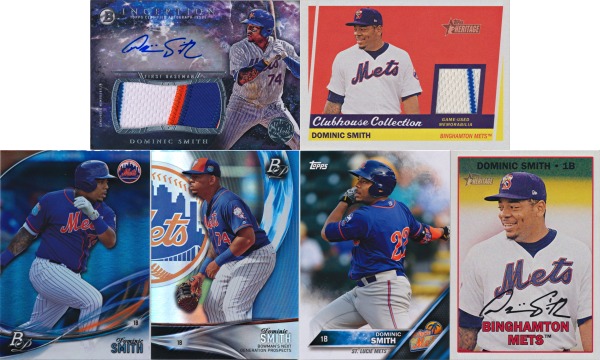 2. Justin Dunn
2. Justin Dunn
Raw Score: 34
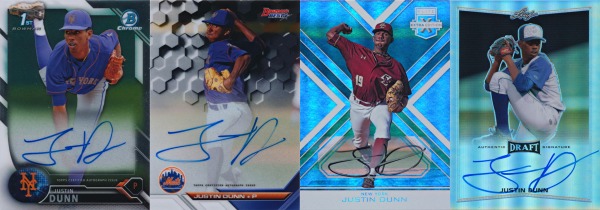 The Mets’ top pick in 2016, Dunn was an obvious choice to appear in every prospect product at the end of the year. Four base autographs and three insert autographs makes Dunn the most diverse signer of the bunch. In any other year, that would be enough to take the top spot. But 2016 wasn’t just any year.
The Mets’ top pick in 2016, Dunn was an obvious choice to appear in every prospect product at the end of the year. Four base autographs and three insert autographs makes Dunn the most diverse signer of the bunch. In any other year, that would be enough to take the top spot. But 2016 wasn’t just any year.
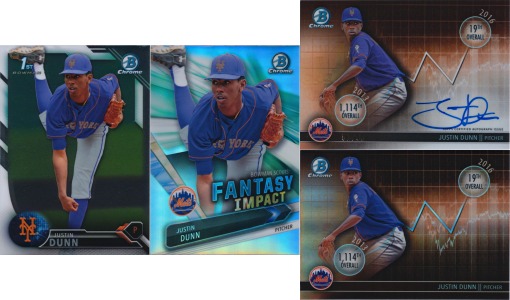 1. Tim Tebow
1. Tim Tebow
Raw Score: 9.5
Weighted Score: 47.5
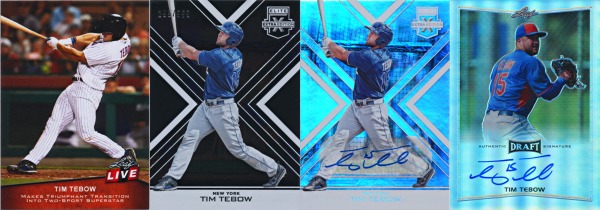 By raw score, Tim Tebow should slot in between Peter Alonso and Anthony Kay. As other prospect lists would undoubtedly note (if he were worth mentioning on any other top prospect lists), his stats just aren’t that good. Not for the top prospect spot, at least. The only thing that really sets him apart is his Leaf Live card, the only one produced so far featuring a Met. Well, that and the huge selling prices for his autographs. With a floor of about $50, Tebow’s base autograph prices put him up there with Matt Harvey, Jacob deGrom, and Michael Conforto as one of the top-selling active Mets players in the last five years and the top active Mets player in 2016. That’s worth enough of a multiplier to put him above Dunn to earn the title of Top Cardboard Mets Prospect of 2016.
By raw score, Tim Tebow should slot in between Peter Alonso and Anthony Kay. As other prospect lists would undoubtedly note (if he were worth mentioning on any other top prospect lists), his stats just aren’t that good. Not for the top prospect spot, at least. The only thing that really sets him apart is his Leaf Live card, the only one produced so far featuring a Met. Well, that and the huge selling prices for his autographs. With a floor of about $50, Tebow’s base autograph prices put him up there with Matt Harvey, Jacob deGrom, and Michael Conforto as one of the top-selling active Mets players in the last five years and the top active Mets player in 2016. That’s worth enough of a multiplier to put him above Dunn to earn the title of Top Cardboard Mets Prospect of 2016.
Honorable Mentions
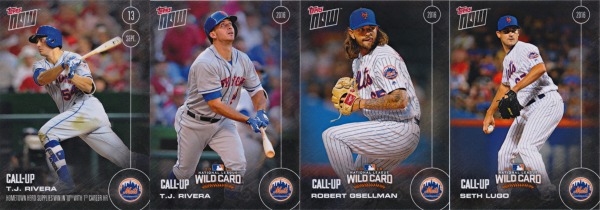 Complicating matters in 2016 was the rise of on-demand(ish) printing from the major card manufacturers. After taking orders for a limited time (usually 24 hours to 1 week), the exact number of cards ordered are printed and shipped, never to be made again. Only Tim Tebow (of course) had one of these in the top 10, but there are a few more that deserve mention. Maybe.
Complicating matters in 2016 was the rise of on-demand(ish) printing from the major card manufacturers. After taking orders for a limited time (usually 24 hours to 1 week), the exact number of cards ordered are printed and shipped, never to be made again. Only Tim Tebow (of course) had one of these in the top 10, but there are a few more that deserve mention. Maybe.
It’s not really clear what these Topps Now cards should count as. Are they base cards? The players in Topps Now were all on active rosters, so they would be eligible to have base cards per MLBPA rules, but none of them featured the RC logo. Are they inserts? Some have a prefix in the card number that would indicate that they could count as inserts, but they are otherwise identical to the “base” versions. Are they really cards at all? They are fully licensed by the MLBPA and MLB Properties, but they don’t come from packs and were sold directly to the consumer like Topps does with wall art and other non-card card-like products. I can’t figure it out, so all pre-RC players with these cards are just getting dumped here.
T.J. Rivera
T.J. Rivera had two Topps Now cards in 2016, one “base” version and one in the Mets postseason team set. That would be enough to at least put him in the tenth spot by points, but the hastily thrown together tiebreaker rule drops him down here. Not getting the RC logo on these cards stings a bit because he might not be in line for many RCs in 2017 products (six other Mets have RC eligibility going into 2017 and four of those are already known to have RCs). But I guess this way there’s a chance…
Robert Gsellman
We last saw Robert Gsellman back in 2014 Bowman Chrome. Two years later, he was up with the Mets in the role of fill-in ace. Despite his looks, he is probably not the second coming of Jacob deGrom. But considering how few people expected it the first time around, Gsellman could be a nice surprise top of the rotation starter in 2017. Which apparently doesn’t count for much on some top prospect lists. There’s not much mystery as to what Gsellman is capable of, only how consistently he can do it. That should be enough to make him a Rookie Card fixture all year long.
Seth Lugo
Seth Lugo may have lost his prospect eligibility after a 2016 that followed the typical Seth Lugo pattern of seemingly overperforming ahead of a looming regression that never comes, but his Rookie Card eligibility remains intact with just this one non-RC card to his name. According to his agent, Lugo signed sticker sheets for Panini, but so far they have yet to appear in any product. He will have his first Rookie Card in 2016 Topps Series 1, but where Lugo will show up next is anyone’s guess, both in cardboard and on the field.
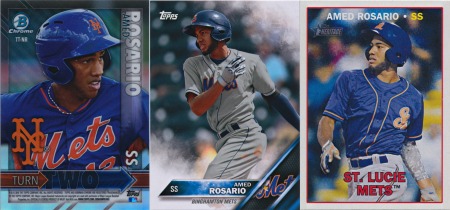
Comments are closed.